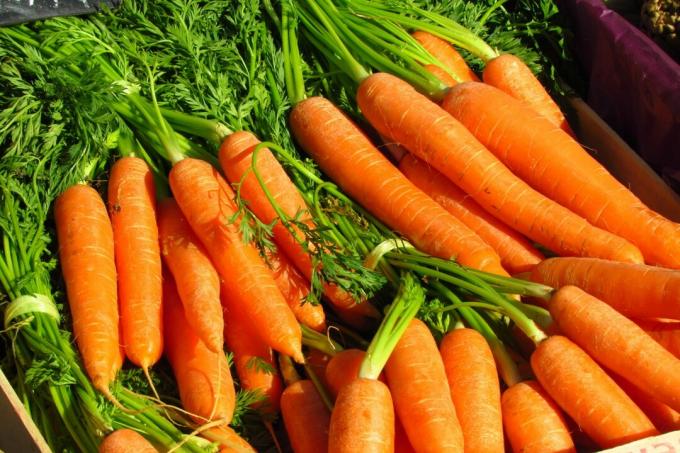A distinction is made between late and early carrot varieties. We give you an overview of the best varieties and give tips on colorful carrot varieties.

carrots or the shorter carrots (Daucus carota), must not be missing in any vegetable garden. The huge selection of varieties sometimes makes it not so easy to decide on the right one.
contents
- Carrot varieties: how to distinguish them?
-
The best varieties of carrots for growing
- Carrot varieties for the balcony or terrace
- Early ripe carrot varieties
- Medium ripe carrot varieties
- Late-ripening carrot varieties
Carrot varieties: how to distinguish them?
The numerous carrot varieties differ in shape, taste, color and storage life. For the hobby gardener it is often particularly interesting which varieties are sown and harvested when and which carrot varieties are easy to store. In general, the growing season of carrots is divided as follows:
- Early carrots: 70-90 days from seed to harvest
- Summer carrots: 110 – 135 days from seed to harvest
- Late Carrots/Storage Carrots: 170-220 days from seed to harvest
In addition, we present carrot varieties that are ideal for growing in small spaces due to their growth and shape.
Tip: The terms carrot and carrot are often used interchangeably, although that's not entirely true: than Carrots are the very short, almost radish-shaped growth forms such as the ‘Pariser’ variety Market'.

The best varieties of carrots for growing
Carrot varieties for the balcony or terrace
- ‘Adelaide (F1)': Early, compact carrot plant with small roots; ideal for cultivation on the balcony or terrace.
- ‘caracas‘: Chantenay-type variety*; tiny, conical roots with a delicate taste.
- ‘kuroda': Early variety with intensely colored orange roots; excellent flavor and delicate in texture; Recommended variety for raw vegetable salads.
- ′Nandor F1′: Compact carrot variety with good characteristics; suitable for growing in flower pots, on the balcony and on the terrace.
- ′Paris Market′: Traditional, proven carrot with spherical, red-orange roots; particularly suitable for hobby cultivation with outstanding taste and delicate texture.
Early ripe carrot varieties
- ′Chantenay′: Early variety with a cylindrical shape and an intense orange colour; as the name suggests, also a variety of the Chantenay type*.
- ′Laguna F1′: Quite early variety with convincingly high yields; cylindrical to slightly blunt root ends.
- ′Nantaise 2′: Well-known variety with cylindrical roots and excellent aroma; early ripening, but also suitable for autumn cultivation for storage.
- ′Sugarsnax 54 F1′: Early carrot variety with high carotene content; very tender and can be eaten raw.
- 'Totem': Well-established, timely variety with high yields; aromatic taste; strong coloring and high carotene content.

Medium ripe carrot varieties
- 'Atomic Red': Long, thin carrot with pink to deep red roots; contains the tomato dye lycopene and tastes strong and crisp.
- ′Chantenay 2′: Medium-ripening variety, cylindrical-conical shaped roots with high-quality pulp; of the Chantenay type*.
- ′Ingot F1′: Newer variety with high yield, good quality and tolerance to carrot fly; the end of the carrot is slightly blunt and rounded.
- ′Lunar White′: White, elongated roots with a mild flavor; probably descended directly from wild carrots.
- ′Purple Haze F1′: Flamboyant, storable variety with a deep purple skin and orange heart; Can be eaten raw with a good aroma and a very high carotene content.
You can grow the 'Purple Haze' carrot yourself with our Plantura vegetable growing set. In addition to the seeds of four other colorful vegetables, a mini greenhouse, substrate, growing pots and plant labels are also included. Cultivation is child's play!
Tip: Carrots need loose, rather sandy soil without stones and compaction. A sufficient supply of potassium increases the yield and the storage life of carrots and improves the taste. If you don't have perfect carrot soil in your garden, you can easily grow them in pots using a potting soil that is high in potassium. One such is ours, for example Plantura organic tomato & vegetable soil.
Late-ripening carrot varieties
- ′Jaune Du Doubs/ Da Forragio′: Late, yellow variety from Italy with very good yield and strikingly large roots; the firm texture of the carrot makes it more suitable for cooking than eating raw; also used as animal feed.
- ′Flakker F1′: Late variety with good taste and excellent storage properties.
- ′Long red blunt without a heart 2/ Vollenda′: Popular variety with good properties; high yields and aromatic taste; very good storage capacity.
- ′Red Giants 2′: Variety with high-quality orange-red flesh; high yields; very good storage carrot.

* Chantenay-type varieties have shorter, tapered carrots. The taste is very aromatic and the carrots do not need to be peeled due to their delicate texture and extremely thin skin.
The desired varieties have been selected and the garden prepared? Carrot growing is one of those things where many things can reduce the yield or even the beauty of the harvest. That's why you'll learn everything you need to know about the right one from us cultivation of carrots.

